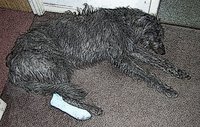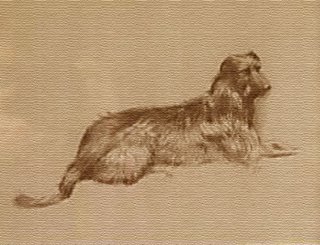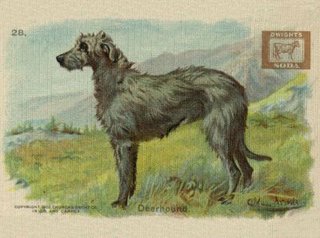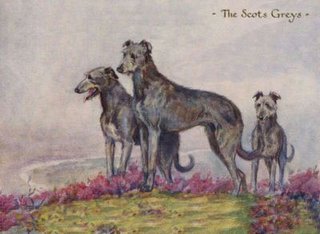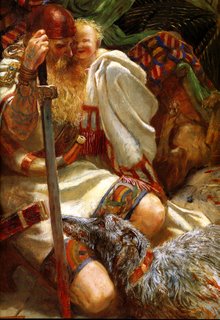
This painting is a wonderfully romantic Victorian era work by the artist (John) Byam (Liston) Shaw (1872-1919). An artist clearly influenced by the Pre-Raphaelites. Some of his other works are among my favourites and it would be all to easy to growl off on a happy highland hound tangent about these other works, but instead I will concentrate more on the painting opposite.
What’s of interest for deerhounds and their owners must be the subject matter of the above work, entitled 'Who Knoweth the Spirit of Man...'.
Based on the folktale featuring yet another hound of Legend . . . Gellert.
The artist depicts the hound to be what we now know as a deerhound, similarly the garb of the Prince including his sword, helmet and indeed, blue warrior paint is portrayed in the dark-ages style, descript of the Pictish warrior.
Interestingly, a type of Welsh language is believed to have been spoken as wide spread as Wales to the Kingdom of Fife in Scotland. And also, another Legendary figure is now thought to have ruled this area as King, that king being King Arthur (more on this in future blogs).
Back to the blog at hand . . . we can draw conclusions from the painting and the period of it’s creation, that influence was probably garnered from the regenerated interest in the Highlands of Scotland, brought about not leastly by Queen Victoria herself.
This is likely to have had effect on the appearance or choice of the dog used as a figure within the portrait. Yes, the ancient rough coated grey hound of the north, now known as the deerhound.
For those that do not know the tale, it is included below and one would think that it would serve as a clear lesson for those who are forcing society into a rush of reaction, before the establishing of true facts. A lesson that Kings, Princes and Rulers of their Worlds fail to learn again and again, thereby allowing the tale to be reborn continually.
The moral aside, it is possible from the tale that the hound temperament could be from a hound of the deerhound line. Read on . . .
Beth GellertWales
Prince Llewellyn had a favorite greyhound named Gellert that had been given to him by his father-in-law, King John. He was as gentle as a lamb at home but a lion in the chase. One day Llewellyn went to the chase and blew his horn in front of his castle. All his other dogs came to the call but Gellert never answered it. So he blew a louder blast on his horn and called Gellert by name, but still the greyhound did not come. At last Prince Llewellyn could wait no longer and went off to the hunt without Gellert. He had little sport that day because Gellert was not there, the swiftest and boldest of his hounds.
He turned back in a rage to his castle, and as he came to the gate, who should he see but Gellert come bounding out to meet him. But when the hound came near him, the prince was startled to see that his lips and fangs were dripping with blood. Llewellyn started back and the greyhound crouched down at his feet as if surprised or afraid at the way his master greeted him.
Now Prince Llewellyn had a little son a year old with whom Gellert used to play, and a terrible thought crossed the prince's mind that made him rush towards the child's nursery. And the nearer he came the more blood and disorder he found about the rooms. He rushed into it and found the child's cradle overturned and daubed with blood.
Prince Llewellyn grew more and more terrified, and sought for his little son everywhere. He could find him nowhere but only signs of some terrible conflict in which much blood had been shed. At last he felt sure the dog had destroyed his child, and shouting to Gellert, "Monster, thou hast devoured my child," he drew out his sword and plunged it in the greyhound's side, who fell with a deep yell and still gazing in his master's eyes.
As Gellert raised his dying yell, a little child's cry answered it from beneath the cradle, and there Llewellyn found his child unharmed and just awakened from sleep. But just beside him lay the body of a great gaunt wolf all torn to pieces and covered with blood. Too late, Llewellyn learned what had happened while he was away. Gellert had stayed behind to guard the child and had fought and slain the wolf that had tried to destroy Llewellyn's heir.
In vain was all Llewellyn's grief; he could not bring his faithful dog to life again. So he buried him outside the castle walls within sight of the great mountain of Snowdon, where every passerby might see his grave, and raised over it a great cairn of stones. And to this day the place is called Beth Gellert, or the Grave of Gellert.
The above source comes from: Joseph Jacobs, Celtic Fairy Tales (London: David Nutt, 1892), no. 21, pp. 192-194.
Jacobs' source: "Beth Gêlert, or the Grave of the Greyhound," a poem by W. R. Spencer privately printed as a broadsheet in 1800. A note by Spencer: "The story of this ballad is traditionary in a village at the foot of Snowdon where Llewellyn the Great had a house. The Greyhound named Gêlert was given him by his father-in-law, King John, in the year 1205, and the place to this day is called Beth-Gêlert, or the grave of Gêlert."
The modern Welsh spelling of the place where Llewellyn's dog is buried is Beddgelert.
This folktale, like so many, represents itself as almost a historical fact. But if we are to dig deep enough, the tale is told repeatedly in similar style throught a wide time frame and across many cultures. Appearing as The Brahman's Wife and the Mongoose from Indias The Panchatantra, The Faithful Dog and the Serpent from Jewish folklore, Folliculus and His Greyhound from ancient Roman Britian or The Farmer and His Dog from The Fables of Æsop. To read these tales visit
this location •

